Vodafone's Business Strategy: Competitive Analysis of UK Telecoms
VerifiedAdded on 2024/06/04
|26
|5606
|399
Report
AI Summary
This report provides a comprehensive analysis of Vodafone's business strategy within the UK telecommunications sector. It begins by examining the external environment using the PESTLE model, considering political, economic, social, technological, legal, and environmental factors affecting Vodafone's operations. The Ansoff's growth vector matrix is applied to assess Vodafone's strategic positioning, focusing on market penetration, market development, product development, and diversification strategies. The report then delves into the internal environment, utilizing the VRIO/VRIN model to determine Vodafone's strategic capabilities, followed by a SWOT analysis to identify the organization's strengths and weaknesses. Porter's five forces model is used to evaluate the competitiveness of the UK's telecommunications sector, leading to the formulation of strategies to improve Vodafone's competitive edge and market position. The analysis considers factors such as the bargaining power of suppliers and buyers, the threat of new entrants and substitute products, and the intensity of competitive rivalry within the industry, ultimately providing recommendations for Vodafone to sustain and enhance its market leadership.
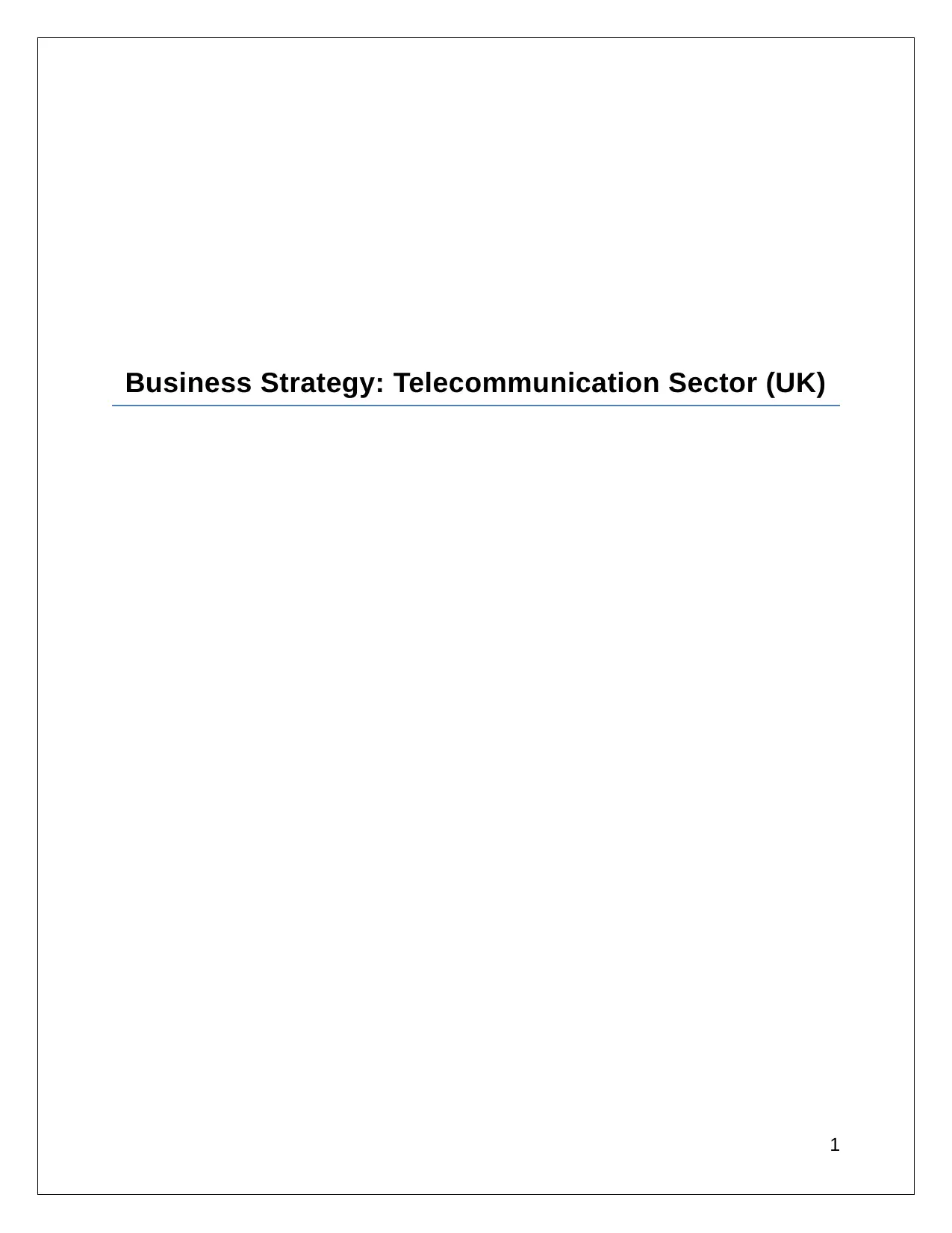
Business Strategy: Telecommunication Sector (UK)
1
1
Paraphrase This Document
Need a fresh take? Get an instant paraphrase of this document with our AI Paraphraser
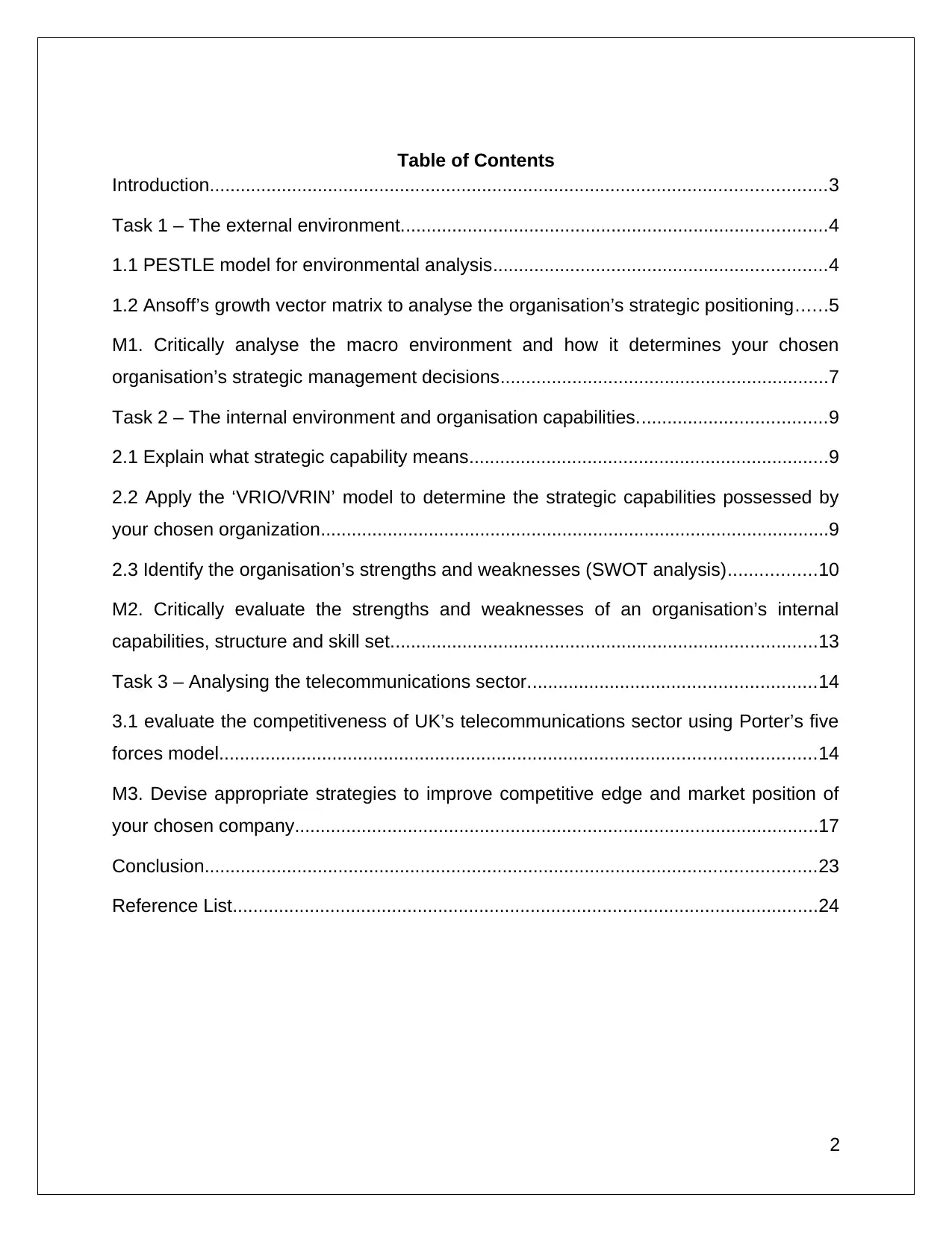
Table of Contents
Introduction........................................................................................................................3
Task 1 – The external environment...................................................................................4
1.1 PESTLE model for environmental analysis.................................................................4
1.2 Ansoff’s growth vector matrix to analyse the organisation’s strategic positioning......5
M1. Critically analyse the macro environment and how it determines your chosen
organisation’s strategic management decisions................................................................7
Task 2 – The internal environment and organisation capabilities.....................................9
2.1 Explain what strategic capability means......................................................................9
2.2 Apply the ‘VRIO/VRIN’ model to determine the strategic capabilities possessed by
your chosen organization...................................................................................................9
2.3 Identify the organisation’s strengths and weaknesses (SWOT analysis).................10
M2. Critically evaluate the strengths and weaknesses of an organisation’s internal
capabilities, structure and skill set...................................................................................13
Task 3 – Analysing the telecommunications sector........................................................14
3.1 evaluate the competitiveness of UK’s telecommunications sector using Porter’s five
forces model....................................................................................................................14
M3. Devise appropriate strategies to improve competitive edge and market position of
your chosen company......................................................................................................17
Conclusion.......................................................................................................................23
Reference List..................................................................................................................24
2
Introduction........................................................................................................................3
Task 1 – The external environment...................................................................................4
1.1 PESTLE model for environmental analysis.................................................................4
1.2 Ansoff’s growth vector matrix to analyse the organisation’s strategic positioning......5
M1. Critically analyse the macro environment and how it determines your chosen
organisation’s strategic management decisions................................................................7
Task 2 – The internal environment and organisation capabilities.....................................9
2.1 Explain what strategic capability means......................................................................9
2.2 Apply the ‘VRIO/VRIN’ model to determine the strategic capabilities possessed by
your chosen organization...................................................................................................9
2.3 Identify the organisation’s strengths and weaknesses (SWOT analysis).................10
M2. Critically evaluate the strengths and weaknesses of an organisation’s internal
capabilities, structure and skill set...................................................................................13
Task 3 – Analysing the telecommunications sector........................................................14
3.1 evaluate the competitiveness of UK’s telecommunications sector using Porter’s five
forces model....................................................................................................................14
M3. Devise appropriate strategies to improve competitive edge and market position of
your chosen company......................................................................................................17
Conclusion.......................................................................................................................23
Reference List..................................................................................................................24
2

Introduction
Mobile telecommunication sector is considered one of the fastest growing sectors in the
global economy sector. With the advent of decentralised and globalised economical
narrative, the global market telecommunication sector has seen exponential growth,
coupled with efficient business strategy, which are adopted to further the market reach.
According to the seventh annual Mobile Consumer Survey (2017) conducted by
Deloitte, shows that more than 53% of the respondents in the 16-75 age group prefer
being engaged with smart phones while walking. The retail revenue generated by the
telecom company range in the first fiscal quarter of 2017 was £3.8bn, an appraisal of
£32m from the previous fiscal quarter. The challenge for the companies has been to
retain their brand image in the market and further their market bases in the international
shores. Vodafone Group Plc is a major player in the telecommunication sector,
providing a range of services such as voice, data and messaging. The company was
found in 1984 and acquired the license of using radio frequencies to deliver the mobile
services. Vodafone has shored out and opened up outlets in various domains,
perpetuating deep in the market sphere (Stirling, 2017).
This assignment will build forth a comprehensive and conclusive analysis, examining
the different nuances associated with the Vodafone telecom industry with the contextual
business strategy and suggesting, in process, the appropriate measures that must be
employed.
3
Mobile telecommunication sector is considered one of the fastest growing sectors in the
global economy sector. With the advent of decentralised and globalised economical
narrative, the global market telecommunication sector has seen exponential growth,
coupled with efficient business strategy, which are adopted to further the market reach.
According to the seventh annual Mobile Consumer Survey (2017) conducted by
Deloitte, shows that more than 53% of the respondents in the 16-75 age group prefer
being engaged with smart phones while walking. The retail revenue generated by the
telecom company range in the first fiscal quarter of 2017 was £3.8bn, an appraisal of
£32m from the previous fiscal quarter. The challenge for the companies has been to
retain their brand image in the market and further their market bases in the international
shores. Vodafone Group Plc is a major player in the telecommunication sector,
providing a range of services such as voice, data and messaging. The company was
found in 1984 and acquired the license of using radio frequencies to deliver the mobile
services. Vodafone has shored out and opened up outlets in various domains,
perpetuating deep in the market sphere (Stirling, 2017).
This assignment will build forth a comprehensive and conclusive analysis, examining
the different nuances associated with the Vodafone telecom industry with the contextual
business strategy and suggesting, in process, the appropriate measures that must be
employed.
3
⊘ This is a preview!⊘
Do you want full access?
Subscribe today to unlock all pages.

Trusted by 1+ million students worldwide
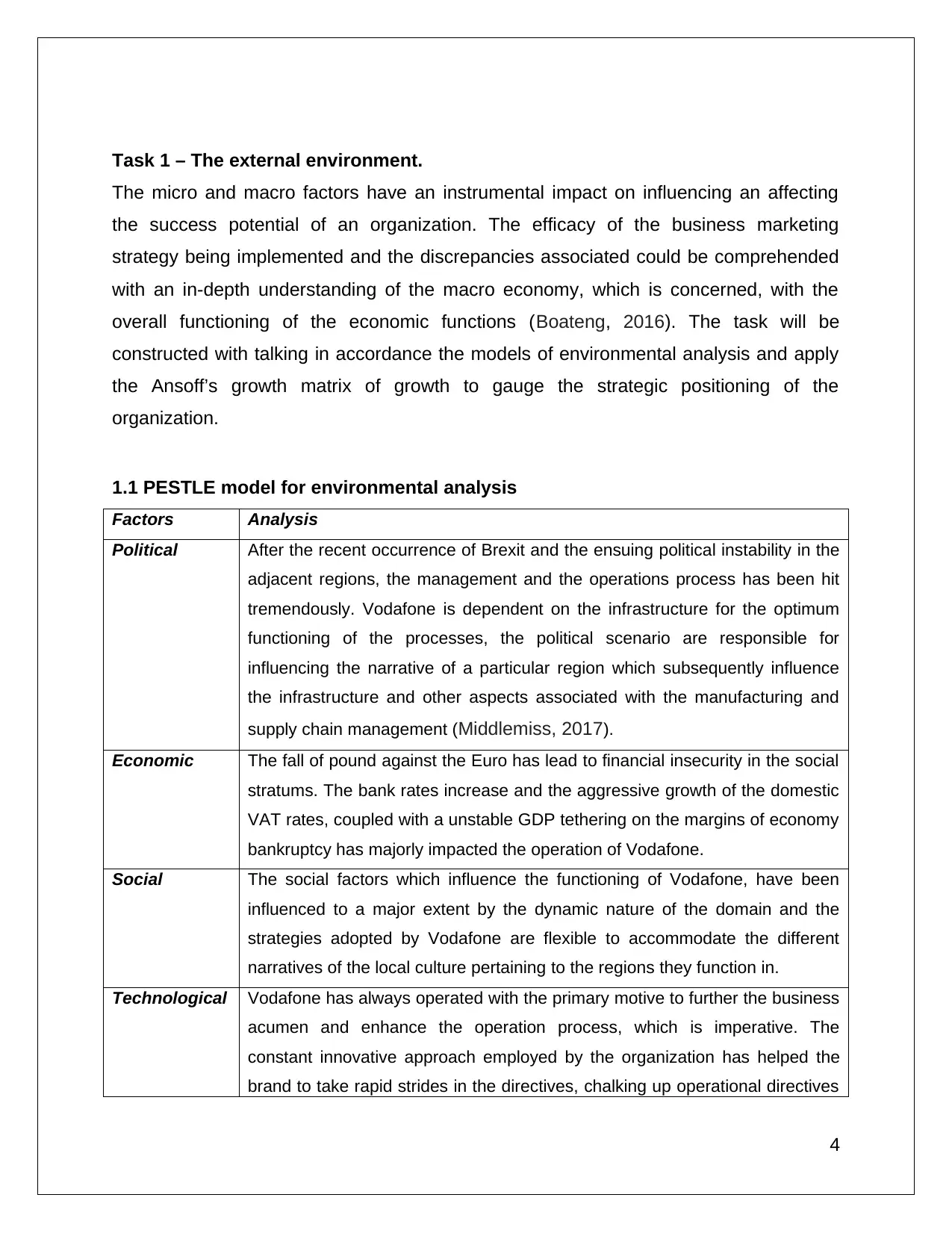
Task 1 – The external environment.
The micro and macro factors have an instrumental impact on influencing an affecting
the success potential of an organization. The efficacy of the business marketing
strategy being implemented and the discrepancies associated could be comprehended
with an in-depth understanding of the macro economy, which is concerned, with the
overall functioning of the economic functions (Boateng, 2016). The task will be
constructed with talking in accordance the models of environmental analysis and apply
the Ansoff’s growth matrix of growth to gauge the strategic positioning of the
organization.
1.1 PESTLE model for environmental analysis
Factors Analysis
Political After the recent occurrence of Brexit and the ensuing political instability in the
adjacent regions, the management and the operations process has been hit
tremendously. Vodafone is dependent on the infrastructure for the optimum
functioning of the processes, the political scenario are responsible for
influencing the narrative of a particular region which subsequently influence
the infrastructure and other aspects associated with the manufacturing and
supply chain management (Middlemiss, 2017).
Economic The fall of pound against the Euro has lead to financial insecurity in the social
stratums. The bank rates increase and the aggressive growth of the domestic
VAT rates, coupled with a unstable GDP tethering on the margins of economy
bankruptcy has majorly impacted the operation of Vodafone.
Social The social factors which influence the functioning of Vodafone, have been
influenced to a major extent by the dynamic nature of the domain and the
strategies adopted by Vodafone are flexible to accommodate the different
narratives of the local culture pertaining to the regions they function in.
Technological Vodafone has always operated with the primary motive to further the business
acumen and enhance the operation process, which is imperative. The
constant innovative approach employed by the organization has helped the
brand to take rapid strides in the directives, chalking up operational directives
4
The micro and macro factors have an instrumental impact on influencing an affecting
the success potential of an organization. The efficacy of the business marketing
strategy being implemented and the discrepancies associated could be comprehended
with an in-depth understanding of the macro economy, which is concerned, with the
overall functioning of the economic functions (Boateng, 2016). The task will be
constructed with talking in accordance the models of environmental analysis and apply
the Ansoff’s growth matrix of growth to gauge the strategic positioning of the
organization.
1.1 PESTLE model for environmental analysis
Factors Analysis
Political After the recent occurrence of Brexit and the ensuing political instability in the
adjacent regions, the management and the operations process has been hit
tremendously. Vodafone is dependent on the infrastructure for the optimum
functioning of the processes, the political scenario are responsible for
influencing the narrative of a particular region which subsequently influence
the infrastructure and other aspects associated with the manufacturing and
supply chain management (Middlemiss, 2017).
Economic The fall of pound against the Euro has lead to financial insecurity in the social
stratums. The bank rates increase and the aggressive growth of the domestic
VAT rates, coupled with a unstable GDP tethering on the margins of economy
bankruptcy has majorly impacted the operation of Vodafone.
Social The social factors which influence the functioning of Vodafone, have been
influenced to a major extent by the dynamic nature of the domain and the
strategies adopted by Vodafone are flexible to accommodate the different
narratives of the local culture pertaining to the regions they function in.
Technological Vodafone has always operated with the primary motive to further the business
acumen and enhance the operation process, which is imperative. The
constant innovative approach employed by the organization has helped the
brand to take rapid strides in the directives, chalking up operational directives
4
Paraphrase This Document
Need a fresh take? Get an instant paraphrase of this document with our AI Paraphraser

and assessing the different forthcoming trends of the market, which helps
them to satiate the needs and the demands of the customer base in a more
competent manner. The initiative to display more innovative technological
offerings in a particular domain such as the Vodafone TObi, the revolutionary
chatbot, and the services for voice authentication currently tested by
Amazon’s Alexa has been conducted with efficiency in the new microsite,
Vodafone Labs.
Legal The EU regulations have had a major impact on the business expansion and
the profitability of Vodafone. The management at Vodafone has taken a very
strict assessment of the legal attributes and has dealt with piracy issues with
vigilance. The organisational structure incorporates the endemic legal
framework and functions with proper adherence of the domain. The
Companies Act of 2006 has been subjected to the change in legislative
structure following Brexit. The UK IPO (Initial Public Offering) has also been
amended with the Brexit and the services for filing patent have been
temporarily suspended which has acted as an hindrance to the operation and
thus affected the businesses of the telecommunication sector, especially
Vodafone (Haaker et al., 2017).
Environmental The advent of a global market space has brought forth a new genre of
customers who are effectively more ethics oriented and consider that the
company, which they associate with, must be especially responsible for
overall development of the society. The management structure at Vodafone
has been dynamic and external and the internal factors are incorporated with
due diligence.
Table 1: PESTLE analysis of Vodafone
(Source: Created by the learner)
1.2 Ansoff’s growth vector matrix to analyse the organisation’s strategic
positioning
Ansoff’s growth vector matrix is compiled for analsying the different alternative
corporate strategies for growth, with keeping in focus the different potential markets and
the products of the firms. Vodadfone has provided the customer base with a wide gamut
5
them to satiate the needs and the demands of the customer base in a more
competent manner. The initiative to display more innovative technological
offerings in a particular domain such as the Vodafone TObi, the revolutionary
chatbot, and the services for voice authentication currently tested by
Amazon’s Alexa has been conducted with efficiency in the new microsite,
Vodafone Labs.
Legal The EU regulations have had a major impact on the business expansion and
the profitability of Vodafone. The management at Vodafone has taken a very
strict assessment of the legal attributes and has dealt with piracy issues with
vigilance. The organisational structure incorporates the endemic legal
framework and functions with proper adherence of the domain. The
Companies Act of 2006 has been subjected to the change in legislative
structure following Brexit. The UK IPO (Initial Public Offering) has also been
amended with the Brexit and the services for filing patent have been
temporarily suspended which has acted as an hindrance to the operation and
thus affected the businesses of the telecommunication sector, especially
Vodafone (Haaker et al., 2017).
Environmental The advent of a global market space has brought forth a new genre of
customers who are effectively more ethics oriented and consider that the
company, which they associate with, must be especially responsible for
overall development of the society. The management structure at Vodafone
has been dynamic and external and the internal factors are incorporated with
due diligence.
Table 1: PESTLE analysis of Vodafone
(Source: Created by the learner)
1.2 Ansoff’s growth vector matrix to analyse the organisation’s strategic
positioning
Ansoff’s growth vector matrix is compiled for analsying the different alternative
corporate strategies for growth, with keeping in focus the different potential markets and
the products of the firms. Vodadfone has provided the customer base with a wide gamut
5

of services and products, effectively tapping in the dynmaics of the maklret to ensure
that the profitability of the organisation is sustained. The company mainly focuses on
bringing new products fore new market segments, relying on the matrix of diversification
for the operational processes. The ansoff matrix is shown below:
Figure 1: Ansoff’s growth vector matrix
(Source: Yin, 2016)
The four major strategies for growth elucidated in the matrix are:
Market penetration: Vodafone has effective incorporated various strategies, which
would essentially enable the organisation to achieve growth, with the aim of enhancing
the market share with the existing product portfolio in the present market segment.
Market penetration is the least risky aspect since the emphasis is on the existing
capabilities and the resources.
Market Development: The market development aspect is constructed with the inclusion
of the pursuit of the additional geographical regions and the unexplored markets
segments. IT is conducted with the consideration of the new market segments; the core
competencies of the organisation must be related to the product with the experiences
6
that the profitability of the organisation is sustained. The company mainly focuses on
bringing new products fore new market segments, relying on the matrix of diversification
for the operational processes. The ansoff matrix is shown below:
Figure 1: Ansoff’s growth vector matrix
(Source: Yin, 2016)
The four major strategies for growth elucidated in the matrix are:
Market penetration: Vodafone has effective incorporated various strategies, which
would essentially enable the organisation to achieve growth, with the aim of enhancing
the market share with the existing product portfolio in the present market segment.
Market penetration is the least risky aspect since the emphasis is on the existing
capabilities and the resources.
Market Development: The market development aspect is constructed with the inclusion
of the pursuit of the additional geographical regions and the unexplored markets
segments. IT is conducted with the consideration of the new market segments; the core
competencies of the organisation must be related to the product with the experiences
6
⊘ This is a preview!⊘
Do you want full access?
Subscribe today to unlock all pages.

Trusted by 1+ million students worldwide
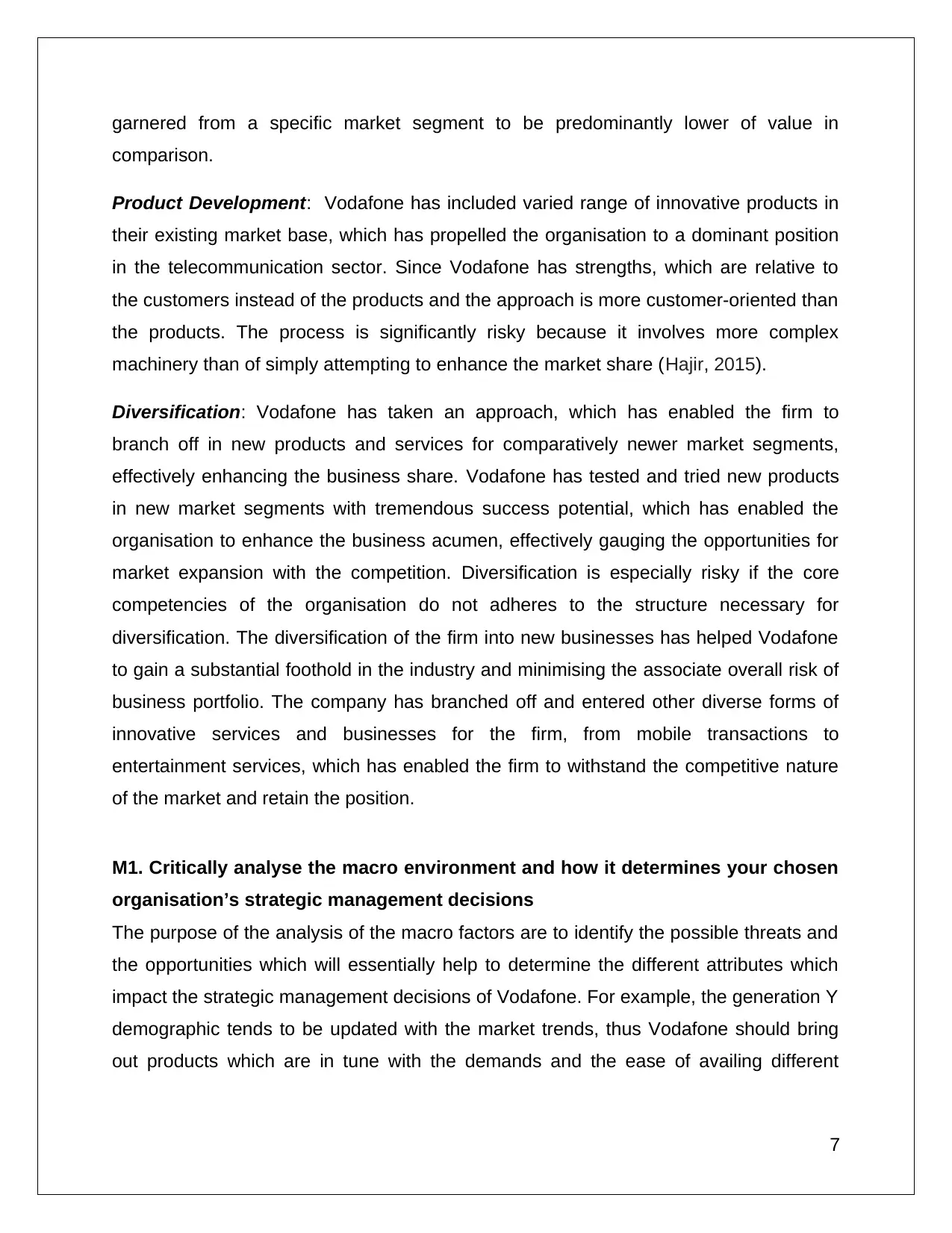
garnered from a specific market segment to be predominantly lower of value in
comparison.
Product Development: Vodafone has included varied range of innovative products in
their existing market base, which has propelled the organisation to a dominant position
in the telecommunication sector. Since Vodafone has strengths, which are relative to
the customers instead of the products and the approach is more customer-oriented than
the products. The process is significantly risky because it involves more complex
machinery than of simply attempting to enhance the market share (Hajir, 2015).
Diversification: Vodafone has taken an approach, which has enabled the firm to
branch off in new products and services for comparatively newer market segments,
effectively enhancing the business share. Vodafone has tested and tried new products
in new market segments with tremendous success potential, which has enabled the
organisation to enhance the business acumen, effectively gauging the opportunities for
market expansion with the competition. Diversification is especially risky if the core
competencies of the organisation do not adheres to the structure necessary for
diversification. The diversification of the firm into new businesses has helped Vodafone
to gain a substantial foothold in the industry and minimising the associate overall risk of
business portfolio. The company has branched off and entered other diverse forms of
innovative services and businesses for the firm, from mobile transactions to
entertainment services, which has enabled the firm to withstand the competitive nature
of the market and retain the position.
M1. Critically analyse the macro environment and how it determines your chosen
organisation’s strategic management decisions
The purpose of the analysis of the macro factors are to identify the possible threats and
the opportunities which will essentially help to determine the different attributes which
impact the strategic management decisions of Vodafone. For example, the generation Y
demographic tends to be updated with the market trends, thus Vodafone should bring
out products which are in tune with the demands and the ease of availing different
7
comparison.
Product Development: Vodafone has included varied range of innovative products in
their existing market base, which has propelled the organisation to a dominant position
in the telecommunication sector. Since Vodafone has strengths, which are relative to
the customers instead of the products and the approach is more customer-oriented than
the products. The process is significantly risky because it involves more complex
machinery than of simply attempting to enhance the market share (Hajir, 2015).
Diversification: Vodafone has taken an approach, which has enabled the firm to
branch off in new products and services for comparatively newer market segments,
effectively enhancing the business share. Vodafone has tested and tried new products
in new market segments with tremendous success potential, which has enabled the
organisation to enhance the business acumen, effectively gauging the opportunities for
market expansion with the competition. Diversification is especially risky if the core
competencies of the organisation do not adheres to the structure necessary for
diversification. The diversification of the firm into new businesses has helped Vodafone
to gain a substantial foothold in the industry and minimising the associate overall risk of
business portfolio. The company has branched off and entered other diverse forms of
innovative services and businesses for the firm, from mobile transactions to
entertainment services, which has enabled the firm to withstand the competitive nature
of the market and retain the position.
M1. Critically analyse the macro environment and how it determines your chosen
organisation’s strategic management decisions
The purpose of the analysis of the macro factors are to identify the possible threats and
the opportunities which will essentially help to determine the different attributes which
impact the strategic management decisions of Vodafone. For example, the generation Y
demographic tends to be updated with the market trends, thus Vodafone should bring
out products which are in tune with the demands and the ease of availing different
7
Paraphrase This Document
Need a fresh take? Get an instant paraphrase of this document with our AI Paraphraser
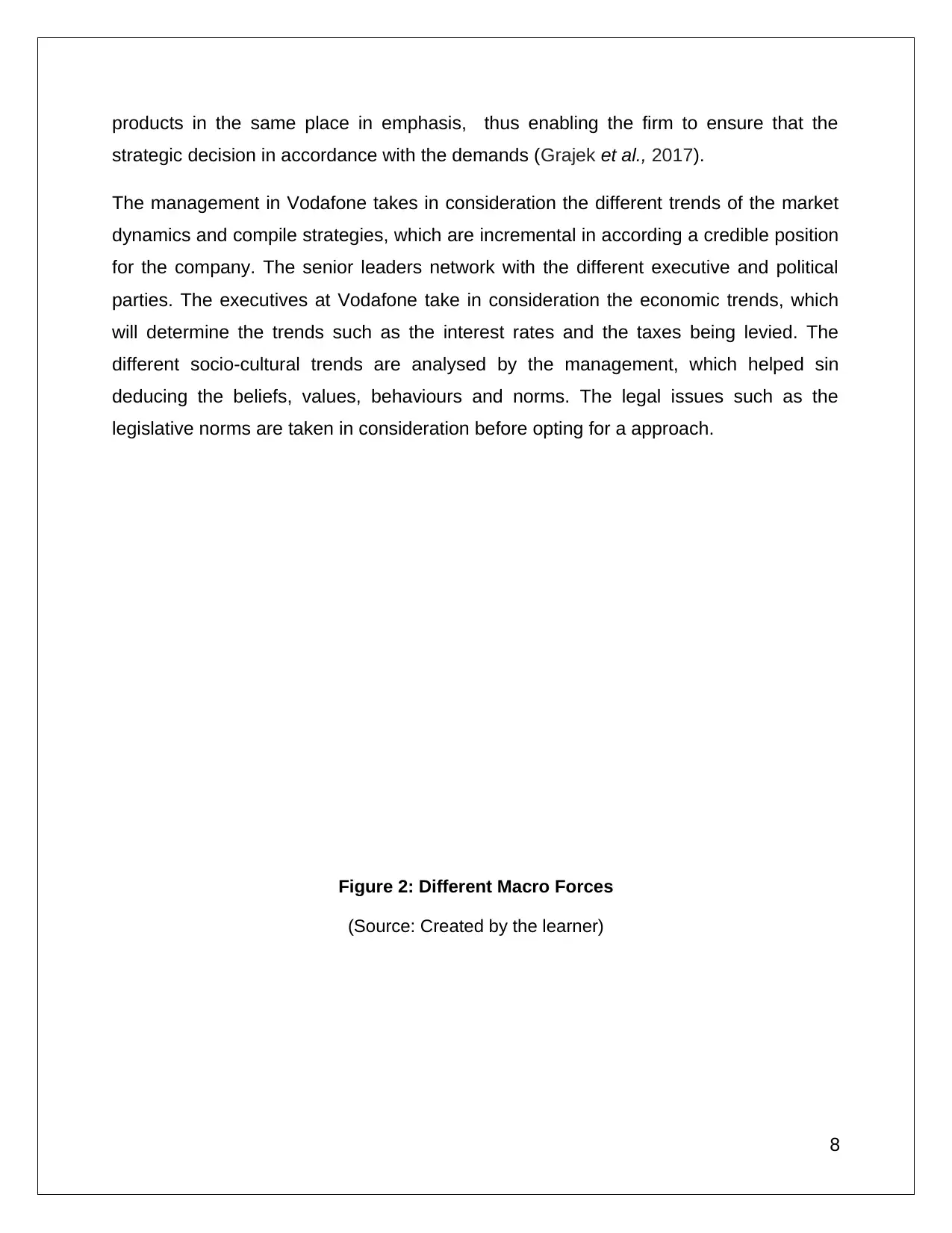
products in the same place in emphasis, thus enabling the firm to ensure that the
strategic decision in accordance with the demands (Grajek et al., 2017).
The management in Vodafone takes in consideration the different trends of the market
dynamics and compile strategies, which are incremental in according a credible position
for the company. The senior leaders network with the different executive and political
parties. The executives at Vodafone take in consideration the economic trends, which
will determine the trends such as the interest rates and the taxes being levied. The
different socio-cultural trends are analysed by the management, which helped sin
deducing the beliefs, values, behaviours and norms. The legal issues such as the
legislative norms are taken in consideration before opting for a approach.
Figure 2: Different Macro Forces
(Source: Created by the learner)
8
strategic decision in accordance with the demands (Grajek et al., 2017).
The management in Vodafone takes in consideration the different trends of the market
dynamics and compile strategies, which are incremental in according a credible position
for the company. The senior leaders network with the different executive and political
parties. The executives at Vodafone take in consideration the economic trends, which
will determine the trends such as the interest rates and the taxes being levied. The
different socio-cultural trends are analysed by the management, which helped sin
deducing the beliefs, values, behaviours and norms. The legal issues such as the
legislative norms are taken in consideration before opting for a approach.
Figure 2: Different Macro Forces
(Source: Created by the learner)
8
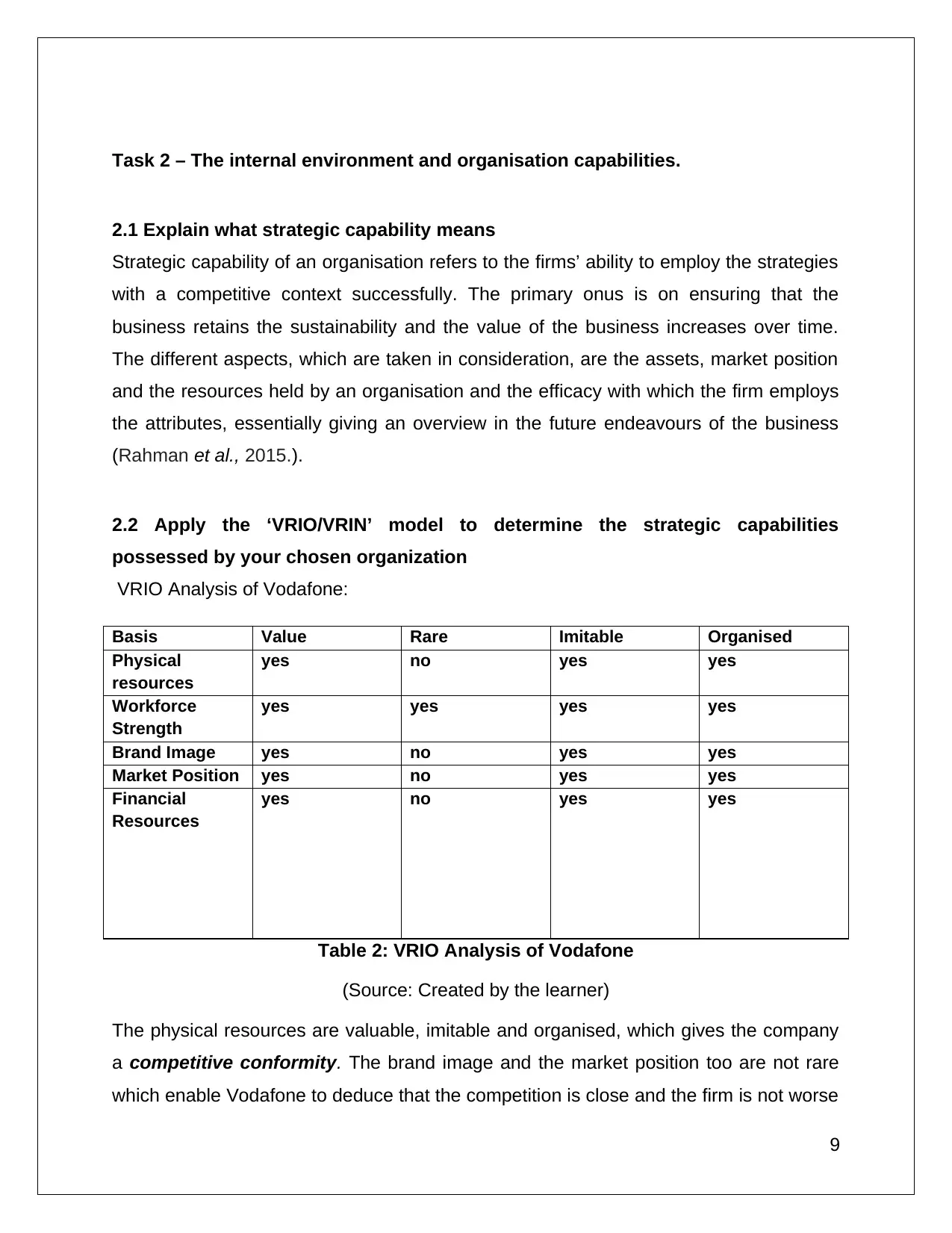
Task 2 – The internal environment and organisation capabilities.
2.1 Explain what strategic capability means
Strategic capability of an organisation refers to the firms’ ability to employ the strategies
with a competitive context successfully. The primary onus is on ensuring that the
business retains the sustainability and the value of the business increases over time.
The different aspects, which are taken in consideration, are the assets, market position
and the resources held by an organisation and the efficacy with which the firm employs
the attributes, essentially giving an overview in the future endeavours of the business
(Rahman et al., 2015.).
2.2 Apply the ‘VRIO/VRIN’ model to determine the strategic capabilities
possessed by your chosen organization
VRIO Analysis of Vodafone:
Basis Value Rare Imitable Organised
Physical
resources
yes no yes yes
Workforce
Strength
yes yes yes yes
Brand Image yes no yes yes
Market Position yes no yes yes
Financial
Resources
yes no yes yes
Table 2: VRIO Analysis of Vodafone
(Source: Created by the learner)
The physical resources are valuable, imitable and organised, which gives the company
a competitive conformity. The brand image and the market position too are not rare
which enable Vodafone to deduce that the competition is close and the firm is not worse
9
2.1 Explain what strategic capability means
Strategic capability of an organisation refers to the firms’ ability to employ the strategies
with a competitive context successfully. The primary onus is on ensuring that the
business retains the sustainability and the value of the business increases over time.
The different aspects, which are taken in consideration, are the assets, market position
and the resources held by an organisation and the efficacy with which the firm employs
the attributes, essentially giving an overview in the future endeavours of the business
(Rahman et al., 2015.).
2.2 Apply the ‘VRIO/VRIN’ model to determine the strategic capabilities
possessed by your chosen organization
VRIO Analysis of Vodafone:
Basis Value Rare Imitable Organised
Physical
resources
yes no yes yes
Workforce
Strength
yes yes yes yes
Brand Image yes no yes yes
Market Position yes no yes yes
Financial
Resources
yes no yes yes
Table 2: VRIO Analysis of Vodafone
(Source: Created by the learner)
The physical resources are valuable, imitable and organised, which gives the company
a competitive conformity. The brand image and the market position too are not rare
which enable Vodafone to deduce that the competition is close and the firm is not worse
9
⊘ This is a preview!⊘
Do you want full access?
Subscribe today to unlock all pages.

Trusted by 1+ million students worldwide
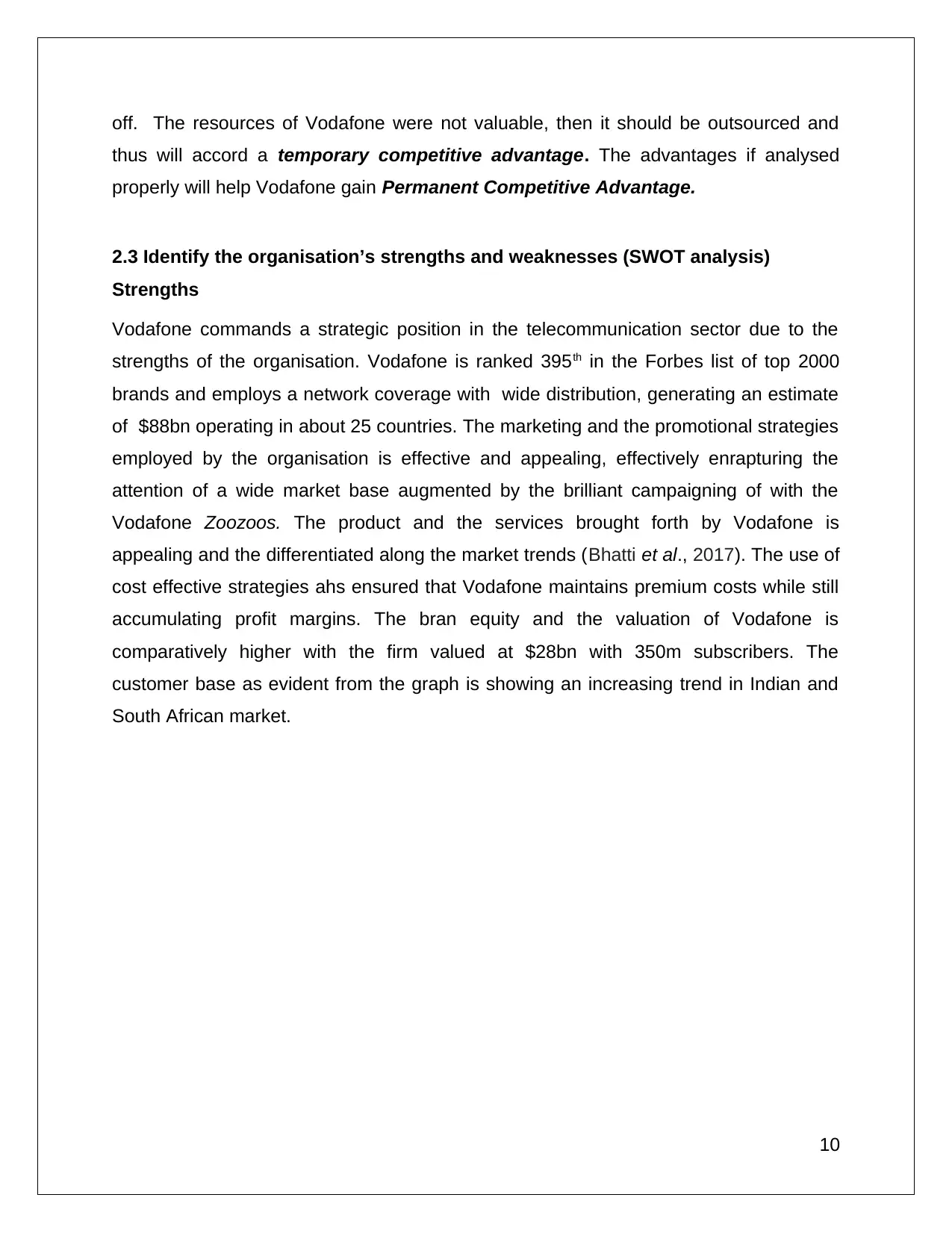
off. The resources of Vodafone were not valuable, then it should be outsourced and
thus will accord a temporary competitive advantage. The advantages if analysed
properly will help Vodafone gain Permanent Competitive Advantage.
2.3 Identify the organisation’s strengths and weaknesses (SWOT analysis)
Strengths
Vodafone commands a strategic position in the telecommunication sector due to the
strengths of the organisation. Vodafone is ranked 395th in the Forbes list of top 2000
brands and employs a network coverage with wide distribution, generating an estimate
of $88bn operating in about 25 countries. The marketing and the promotional strategies
employed by the organisation is effective and appealing, effectively enrapturing the
attention of a wide market base augmented by the brilliant campaigning of with the
Vodafone Zoozoos. The product and the services brought forth by Vodafone is
appealing and the differentiated along the market trends (Bhatti et al., 2017). The use of
cost effective strategies ahs ensured that Vodafone maintains premium costs while still
accumulating profit margins. The bran equity and the valuation of Vodafone is
comparatively higher with the firm valued at $28bn with 350m subscribers. The
customer base as evident from the graph is showing an increasing trend in Indian and
South African market.
10
thus will accord a temporary competitive advantage. The advantages if analysed
properly will help Vodafone gain Permanent Competitive Advantage.
2.3 Identify the organisation’s strengths and weaknesses (SWOT analysis)
Strengths
Vodafone commands a strategic position in the telecommunication sector due to the
strengths of the organisation. Vodafone is ranked 395th in the Forbes list of top 2000
brands and employs a network coverage with wide distribution, generating an estimate
of $88bn operating in about 25 countries. The marketing and the promotional strategies
employed by the organisation is effective and appealing, effectively enrapturing the
attention of a wide market base augmented by the brilliant campaigning of with the
Vodafone Zoozoos. The product and the services brought forth by Vodafone is
appealing and the differentiated along the market trends (Bhatti et al., 2017). The use of
cost effective strategies ahs ensured that Vodafone maintains premium costs while still
accumulating profit margins. The bran equity and the valuation of Vodafone is
comparatively higher with the firm valued at $28bn with 350m subscribers. The
customer base as evident from the graph is showing an increasing trend in Indian and
South African market.
10
Paraphrase This Document
Need a fresh take? Get an instant paraphrase of this document with our AI Paraphraser

Figure 3: Customer Base of Vodafone in different countries
(Source: Abushova, 2016)
Weaknesses
The political instability in the UK market has led to dropping revenue generation; the
negative trend has affected the company operations. The consequences of post 2008
depression along with Brexit has lead to a drop in the brand valuation of Vodafone, in
the wake of a struggling economy. The brand valuation and the subscriber brand were
significantly strong but the ensuing repercussions triggered by the political and
legislative amendments have changed the market dynamics which needs the better
incorporation of the core values and the strengths of the organisation. The table given
below states how the brand valuation of Vodafone suffered a hit with $27.82 in 2016 to
a drop to $21.83 in 2017. The overall fall in the three-year period has been from $29.61
in 2014 to $21.83 in 2017, an estimate collapse of $7.78.
11
(Source: Abushova, 2016)
Weaknesses
The political instability in the UK market has led to dropping revenue generation; the
negative trend has affected the company operations. The consequences of post 2008
depression along with Brexit has lead to a drop in the brand valuation of Vodafone, in
the wake of a struggling economy. The brand valuation and the subscriber brand were
significantly strong but the ensuing repercussions triggered by the political and
legislative amendments have changed the market dynamics which needs the better
incorporation of the core values and the strengths of the organisation. The table given
below states how the brand valuation of Vodafone suffered a hit with $27.82 in 2016 to
a drop to $21.83 in 2017. The overall fall in the three-year period has been from $29.61
in 2014 to $21.83 in 2017, an estimate collapse of $7.78.
11

Figure 4: Brand value depreciation of Vodafone
(Source: Abushova, 2016)
Opportunities
The opportunities of Vodafone are not domain specific. The emergence of rural market
in the Asiatic countries and the African market has helped enhance the sales. The high
percentage among the subscriber base pertaining to the overseas markets are from
rural areas, evidently showing a market which can be tapped in order to utilise the
market competition and increase the revenue generation. The Deloitte survey of annual
Mobile Consumer Survey states how the Smartphone market is showing an upwards
trend and subsequently the parallel dependency on the cellular dependency is showing
an increase. The network coverage of Vodafone is an opportunity to emphasize on, the
onus being on including as many regions in the company coverage to enable efficient
customer acquisition and thus retain and acquire new customers (Howard, 2015).
Threats
12
(Source: Abushova, 2016)
Opportunities
The opportunities of Vodafone are not domain specific. The emergence of rural market
in the Asiatic countries and the African market has helped enhance the sales. The high
percentage among the subscriber base pertaining to the overseas markets are from
rural areas, evidently showing a market which can be tapped in order to utilise the
market competition and increase the revenue generation. The Deloitte survey of annual
Mobile Consumer Survey states how the Smartphone market is showing an upwards
trend and subsequently the parallel dependency on the cellular dependency is showing
an increase. The network coverage of Vodafone is an opportunity to emphasize on, the
onus being on including as many regions in the company coverage to enable efficient
customer acquisition and thus retain and acquire new customers (Howard, 2015).
Threats
12
⊘ This is a preview!⊘
Do you want full access?
Subscribe today to unlock all pages.

Trusted by 1+ million students worldwide
1 out of 26
Related Documents
Your All-in-One AI-Powered Toolkit for Academic Success.
+13062052269
info@desklib.com
Available 24*7 on WhatsApp / Email
![[object Object]](/_next/static/media/star-bottom.7253800d.svg)
Unlock your academic potential
Copyright © 2020–2026 A2Z Services. All Rights Reserved. Developed and managed by ZUCOL.



